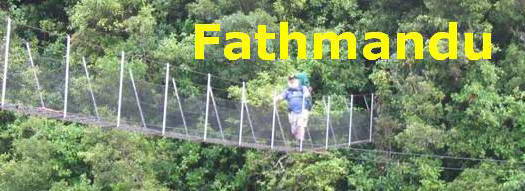
Many thanks for permission to use graphics from their software and toposheets |
 |
|
21 February 2007 The "Excuse Me" Trailpage 2 First thing I noticed was the lushness of the forest. This was to be a feature of the first two days. Especially noticeable was the Crown Fern (Piupiu, Blechnum discolor) - some of these were more than two metres:
The track was benched, well-surfaced, and the grade was easy - for the first few hundred yards it was nearly flat. The topo map does not take account of the winds and twists of the track as it heads up through what would otherwise be quite steep territory.
What I would simply call bush lawyer in the Waitaks down here demands a litle more attention. It's much more varied in habit. This, I think is Rubus schmidelioides - identified from its reddish prickles.
The ferns are growing lushly, and so many it's impossible yet for me to hold them all in my head.
Later on we will travel through beech forest that seems dry and harsh - so dry it seems to suck the moisture from the air around you like a wick and you can almost feel the dryness on your skin, and nothing grows underneath and dead trees lie strewn everywhere, but here it is lush and green. Also enjoying the lushness in this part of the world is the stinging nettle. I think this one is Urtica urens. Tomorrow we find Urtica ferox, the ongaonga, a much more savage beast. It's like comparing a 12 volt electric fence with a mains driven model. U. urens is an annual, growing to about 600mm in height, and often found on the edges of tramping tracks where it can whack an unprotected ankle. Miranda gets bitten by one that is growing out of a hollow ponga stump at elbow height. U. ferox grows to the height of a small tree and can kill susceptible persons. Its leaves are longer and narrower and more fiercely serrate.
Aristotelia (wine berry) leaves when small are somewhat similar but its leaves are bigger and there are no stinging hairs.
The rainfall around here is about 3-4 metres a year. Trampers are routinely warned to expect at least one day of rain on a three day walk. We had one night of rain at McKellar hut, and 9 bluetop days. Great stuff. A wall of fern
And again. Here you can see filmy ferns, Hymenophyllum, along with a bunch of others. These are found down here in far more variety than in Auckland.
The path begins to climb slowly and veer to the right. I'm pleased to be still this close to the main bunch as it were.
Here's a delightful small fern emerging from the litter.
Here is a small native buttercup growing beside the track. I'm not familiar enough with alpine flowers to name this straight off, but watch this space.
In amongst the profusion of ferns, marble leaf (putaputaweta, Carpodetus serratus) finds a congenial home in the damp conditions.
Another nettle. This one just might be a young ongaonga.
There's no points for finding out the hard way, so I take a pic, and give it a wide berth. This is the kind of detail that really makes you appreciate the job DoC does on these tracks. Imagine climbing over that with a full pack. (We did it a couple of years ago with a newly fallen tree on the Heaphy. It's hard work, especially in steep country.)
We're now starting to climb more seriously. The track is still immaculate.
Just around the corner a little, Carol and Mike take a brief break and wait for us to catch up. After the Rees-Dart and their brief sprint up to the Greenstone hut this must seem like a trip to the dairy. If you have a look at the front of Miranda's pack harness you will notice, just where the shoulder strap crosses the collar bone, two pieces of soft foam rubber about 125x100x50mm. Miranda's collar bone sits slightly proud and these pads make a world of difference to her comfort. (Dan's idea. Excellent.)
To the right of Carol's pack is a Kathmandu camelback. Most good packs these days are designed to attach these or something similar, either internally or externally, but even with older packs it's usually easy enough to fasten them on, and they do give wonderful access to water on the hoof.
|
|